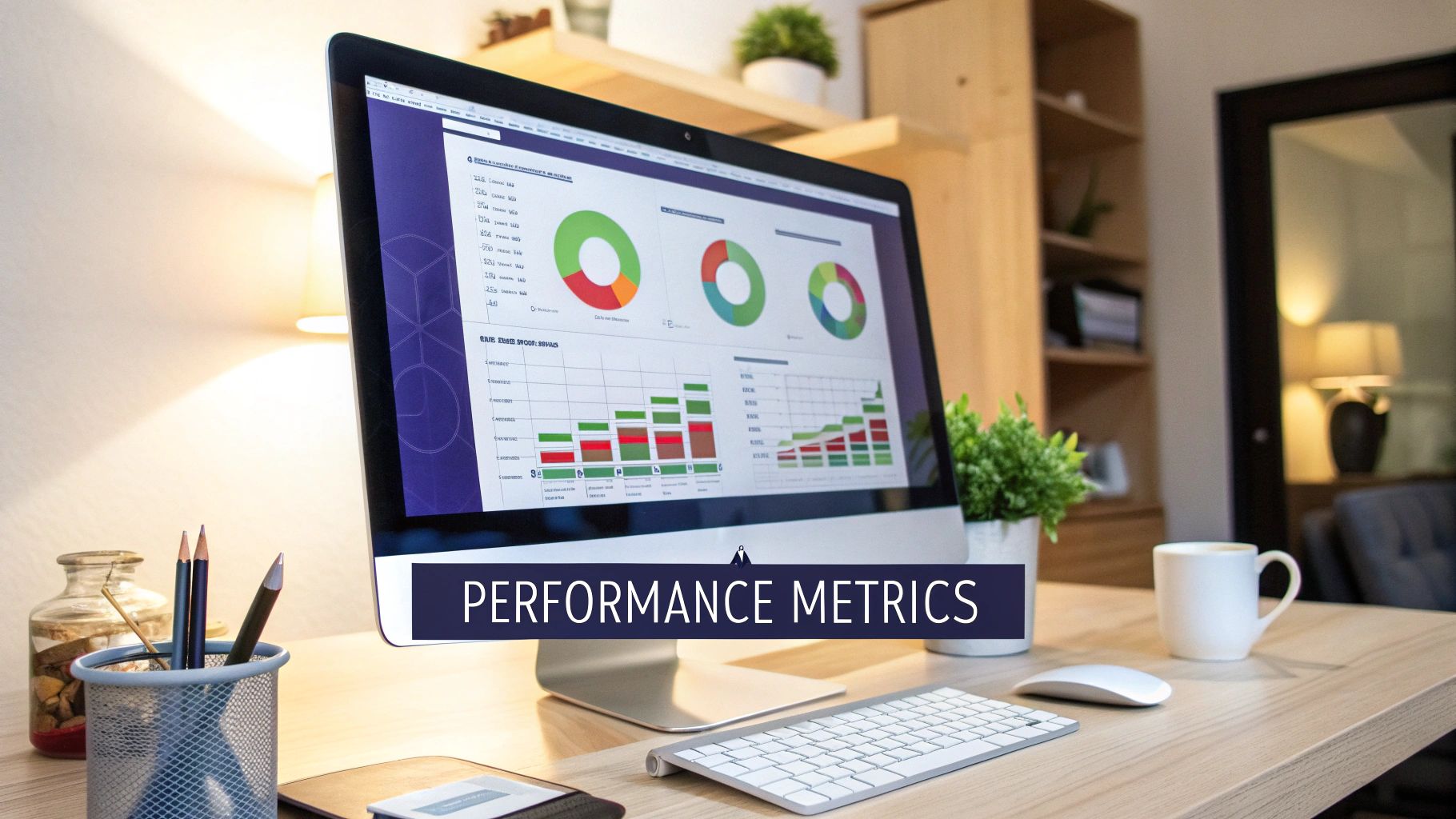9 Real Estate Asset Management Best Practices for Superior Returns
- Ryan McDowell

- Aug 16
- 14 min read
Reading Time: 8 min | Good for: Novice Investors (A), Family Offices (B), CIOs (C)
In the world of institutional real estate, closing the deal is just the beginning. True, long-term wealth creation hinges on what happens after the acquisition: the disciplined, strategic, and proactive management of each asset. For sophisticated investors, family offices, and those exploring passive commercial real estate, understanding the operational levers that drive performance is paramount to successful allocation. Mediocre operations can erode even the most promising acquisitions, while elite asset management can unlock significant hidden value.
This guide moves beyond theory to provide a definitive roundup of the nine essential asset management best practices that top-tier sponsors employ. These are the specific strategies used to protect capital, optimize returns, and deliver consistent performance through various market cycles.
TL;DR: Key Takeaways for Investors
Foundation First: Elite asset management starts with a perfect inventory and a risk-based plan. Know what you own, its condition, and which assets pose the biggest threat if they fail.
Data Drives Dollars: Predictive maintenance and Total Cost of Ownership (TCO) analysis shift asset management from a cost center to a value driver, preventing expensive failures and optimizing capital spend.
Integrated Systems Win: Top sponsors use Enterprise Asset Management Systems (EAMS) and clear Key Performance Indicators (KPIs) to create a single source of truth, ensuring every decision is data-backed and aligned with portfolio goals.
Investor Diligence: The quality of a sponsor's asset management is a direct proxy for their institutional capabilities. Use this guide as a checklist when evaluating potential partners.
1. Comprehensive Asset Inventory and Documentation
The foundation of any successful asset management strategy is knowing precisely what you own, where it is, and its current condition. A comprehensive asset inventory is a systematic process of cataloging every physical and intangible asset within a real estate portfolio. This goes beyond a simple property list; it involves creating a centralized, dynamic database that tracks each asset from acquisition through its operational life to its eventual disposal. For commercial real estate investors, this means documenting everything from the building itself to critical systems like HVAC, roofing, and elevators, as well as leases, warranties, and service contracts.

This meticulous documentation serves as the single source of truth for all strategic decisions. It enables accurate capital expenditure forecasting, preventative maintenance scheduling, and streamlined due diligence for future transactions. As institutional investors like General Electric have shown with their digital registries for industrial equipment, a detailed inventory provides the visibility needed to optimize performance, mitigate risks, and maximize value across a global portfolio. This practice is a core component of the ISO 55000 standards and is one of the most crucial asset management best practices for institutional-grade operations.
How to Implement a Comprehensive Inventory
Start with High-Value Systems: Begin by documenting the most critical and highest-value assets, such as structural components, MEP (mechanical, electrical, plumbing) systems, and fire safety equipment, before expanding to less critical items.
Utilize Technology for Efficiency: Implement barcode or RFID tagging for major equipment. This allows for rapid, accurate tracking and simplifies physical audits, reducing manual data entry errors.
Standardize Data Entry: Establish clear naming conventions and categorization standards for all assets. Consistency is key to ensuring the data is searchable, scalable, and useful for analytics.
Conduct Regular Audits: Schedule periodic physical audits of your properties to verify the accuracy of your digital inventory, updating conditions, and noting any unrecorded changes.
Novice Lens: Think of this as the ultimate home inspection report for a commercial property, but one that is constantly updated. It's the baseline "what do we own?" that prevents costly surprises down the road.
2. Risk-Based Asset Management Strategy
An advanced asset management approach moves beyond routine maintenance schedules to prioritize activities based on the potential consequences of failure. A risk-based strategy evaluates assets according to their criticality to operations, potential safety and environmental impacts, and financial ramifications if they fail. This methodology allows investors to allocate capital and operational resources with surgical precision, focusing attention on the assets that pose the greatest risk to the portfolio’s objectives. For real estate investors, this means prioritizing a failing rooftop HVAC unit on a fully-leased data center over a cosmetic issue at a vacant property.

This strategic focus ensures that limited resources generate the maximum protective value, mitigating the most severe potential losses first. Organizations like Shell have long used risk-based inspection programs for critical refinery equipment to optimize uptime and safety, a principle directly applicable to real estate. By quantifying both the likelihood and impact of asset failure, owners can make data-driven decisions that safeguard revenue streams and enhance long-term resilience. Embracing this methodology is one of the core asset management best practices for protecting and growing institutional-grade portfolios. For a deeper understanding of potential financial hazards, you can learn more about the types of investment risk in real estate and how to manage them.
How to Implement a Risk-Based Strategy
Develop Standardized Risk Criteria: Create a consistent risk matrix (e.g., combining probability and impact scores) to evaluate all assets, from structural elements to tenant leases. This ensures objective comparisons across the portfolio.
Include Cross-Functional Teams: Involve property managers, engineers, and finance professionals in risk assessments. This provides a holistic view, incorporating operational realities and financial consequences.
Use Historical Data: Analyze past failure data and maintenance records to inform probability assessments. This data grounds your risk model in real-world performance rather than assumptions.
Regularly Review and Update Assessments: Risk is not static. Periodically reassess asset criticality as market conditions, tenant profiles, and building usage change.
3. Predictive Maintenance and Condition Monitoring
Moving beyond reactive or scheduled repairs, predictive maintenance represents a sophisticated, data-driven approach to asset upkeep. This strategy uses technologies like Internet of Things (IoT) sensors and machine learning to analyze real-time operational data from critical systems. By identifying patterns and anomalies that precede equipment failure, asset managers can address potential issues before they cause costly downtime or catastrophic damage. For a real estate portfolio, this means monitoring HVAC performance, elevator operations, and electrical loads to predict maintenance needs with remarkable accuracy.

This proactive stance transforms maintenance from a cost center into a strategic value driver. By servicing equipment precisely when needed, organizations can extend asset lifecycles, reduce emergency repair costs, and improve tenant satisfaction through enhanced building reliability. Industry leaders like General Electric, with its Predix platform for industrial assets, have proven that predictive analytics significantly boosts operational efficiency. Implementing this forward-looking strategy is one of the most impactful asset management best practices for protecting capital-intensive building systems and maximizing net operating income.
How to Implement Predictive Maintenance
Start with Critical Assets: Launch a pilot program focused on high-value, high-impact systems such as chillers, boilers, or primary electrical switchgear where failure would cause the most significant disruption.
Invest in Staff Training: Equip your facilities and asset management teams with the skills to interpret data from monitoring systems. Understanding the analytics is just as important as collecting the data.
Establish Alert Thresholds: Define clear operational parameters and thresholds that trigger maintenance alerts. Create standardized escalation procedures so your team knows exactly how to respond when an anomaly is detected.
Integrate with Work Order Systems: Connect predictive maintenance alerts directly to your Computerized Maintenance Management System (CMMS) to automate work order creation, ensuring rapid response and seamless tracking.
4. Total Cost of Ownership (TCO) Analysis
Effective asset management requires looking beyond the initial purchase price to understand the full financial impact of an asset over its entire life. Total Cost of Ownership (TCO) is a comprehensive financial methodology that evaluates every cost associated with owning and operating a property, from acquisition to disposal. This includes not just the sticker price but also operating expenses, maintenance and repair costs, capital improvements, and eventual decommissioning or sale-related expenses. By adopting this holistic view, investors can make far more informed capital allocation decisions.

This methodology, popularized in enterprise IT and defense acquisition by organizations like Gartner and the U.S. Department of Defense, is one of the most powerful asset management best practices when applied to commercial real estate. It prevents the common pitfall of selecting a lower-priced asset that ultimately incurs higher long-term costs. For example, a cheaper roofing system might save money upfront but require replacement years sooner than a more durable, albeit more expensive, alternative, resulting in a higher TCO. Considering these factors is crucial, and investors can learn more about the opportunity cost of inaction and its impact on long-term value.
How to Implement TCO Analysis
Identify All Cost Categories: Work with property managers, facility engineers, and financial analysts to map out all potential costs, including acquisition, operations, maintenance, upgrades, and disposal.
Use Data to Validate Projections: Leverage historical data from comparable assets within your portfolio to build realistic cost assumptions. For new asset types, consult industry benchmarks and expert analyses.
Standardize Your TCO Model: Develop a consistent TCO framework to be used across all potential acquisitions and major capital projects. This ensures that you are comparing investment options on an equal footing.
Update Models with Actuals: As an asset moves through its lifecycle, regularly update your TCO model with actual cost data. This refines the accuracy of your future projections and improves decision-making.
Advanced Lens: When evaluating a sponsor's TCO model, scrutinize their assumptions for key variables like energy cost inflation, labor rate escalation, and the terminal value discount rate. Sophisticated models will include sensitivity analysis for these inputs.
5. Integrated Asset Management Systems (EAMS)
Moving beyond spreadsheets and siloed software, Enterprise Asset Management Systems (EAMS) represent a transformative leap in portfolio oversight. An EAMS is a comprehensive technology platform that centralizes every facet of asset management, integrating maintenance schedules, procurement, financial data, and performance reporting into a single, unified system. For commercial real estate investors, this means having a cohesive, real-time view of the entire asset lifecycle, from acquisition and capital planning through operations and eventual disposition. This centralized command center improves data consistency, streamlines workflows, and empowers data-driven decision-making.
The power of an EAMS lies in its ability to connect disparate functions and provide actionable intelligence. Leading platforms like IBM Maximo, utilized by major utilities, or SAP Asset Management, deployed by manufacturing giants, showcase how integrated systems can optimize complex portfolios. An EAMS can automatically trigger a work order based on a sensor reading, track the associated costs, and update financial forecasts simultaneously. For sophisticated investors, adopting an EAMS is a critical step toward institutional-grade operations and one of the most impactful asset management best practices for achieving scalable efficiency and maximizing portfolio returns.
How to Implement an Integrated Asset Management System
Conduct a Thorough Needs Analysis: Before selecting a system, map out all existing workflows, identify pain points, and define specific, measurable goals. This ensures the chosen platform aligns with your unique operational requirements.
Plan for Change Management: Implementing an EAMS is a significant organizational shift. Develop a comprehensive training program and communication plan to ensure user adoption and secure buy-in from all stakeholders, from property managers to the C-suite.
Establish Robust Data Governance: Prior to deployment, create clear standards for data entry, management, and security. Consistent, clean data is the fuel for any successful EAMS, so governance is non-negotiable.
Implement in Phases: Avoid a "big bang" rollout. Start with a pilot program at a single property or focus on one core module, like preventative maintenance, to minimize disruption, gather feedback, and refine the process before expanding across the portfolio.
6. Performance Metrics and KPI Monitoring
What gets measured gets managed. A systematic approach to monitoring performance through key performance indicators (KPIs) is essential for evaluating the success of your asset management strategy. This practice involves establishing clear benchmarks, setting ambitious yet achievable targets, and continuously tracking progress. For real estate investors, this means moving beyond simple rent collection figures to sophisticated metrics that reveal insights into operational efficiency, tenant satisfaction, maintenance effectiveness, and overall portfolio health. It’s about transforming raw data into actionable intelligence.
This disciplined monitoring provides the critical feedback loop needed to make informed, data-driven decisions. Leading firms like Chevron use integrated performance measurement systems to optimize their global operations, demonstrating how a robust KPI framework can drive value and mitigate risk. By tracking the right metrics, you can identify underperforming assets, pinpoint operational inefficiencies, and allocate capital more effectively. Adopting this strategy is a hallmark of institutional-grade operations and a fundamental component of the asset management best practices promoted by organizations like the Society for Maintenance & Reliability Professionals (SMRP).
How to Implement Performance Metrics and KPI Monitoring
Align Metrics with Strategic Goals: Select KPIs that directly reflect your primary business objectives. For example, if your goal is to maximize long-term value, track metrics like Net Operating Income (NOI) growth, cash-on-cash return, and tenant retention rates. Learn more about decoding asset management performance metrics to choose the most impactful ones.
Focus on Leading Indicators: While lagging indicators like historical ROI are important, prioritize leading indicators that predict future performance. These might include metrics like lease renewal probability, average days on market for vacant units, or preventative maintenance completion rates.
Establish a Centralized Dashboard: Use asset management software or business intelligence tools to create a single, accessible dashboard. This ensures that all stakeholders, from property managers to investors, are viewing the same consistent and up-to-date data.
Review and Adapt Regularly: Markets and asset conditions change. Schedule quarterly or semi-annual reviews of your KPIs to ensure they remain relevant and are driving the desired behaviors and outcomes across your team.
7. Lifecycle Asset Planning and Optimization
A truly strategic approach to asset management extends beyond day-to-day operations to encompass the entire lifecycle of an asset. Lifecycle planning involves making informed decisions from initial acquisition through operation, maintenance, renewal, and eventual disposal. This forward-looking process ensures that every capital investment and operational choice aligns with long-term portfolio objectives, considering factors like technological evolution, regulatory shifts, and changing market demand. For sophisticated real estate investors, this means optimizing the total cost of ownership, not just the upfront purchase price.
This holistic view prevents costly short-term fixes that compromise long-term value. For instance, selecting a cheaper HVAC system might save capital initially but lead to higher energy bills and more frequent replacement costs down the line, eroding net operating income. Pioneers in infrastructure, like Singapore's Public Utilities Board, use comprehensive lifecycle models to manage their water systems for decades-long resilience and efficiency. Adopting this framework is one of the most impactful asset management best practices, as it directly links capital planning to sustainable, long-term value creation and risk mitigation, a cornerstone of the ISO 55000 framework.
How to Implement Lifecycle Planning
Develop Asset-Specific Strategies: Create distinct lifecycle plans for critical systems (e.g., roof, elevators, MEP). Each plan should outline projected service life, maintenance schedules, capital replacement costs, and disposal strategies.
Integrate Financial and Operational Data: Use asset management software to connect financial forecasts with real-time operational performance data. This allows you to model the total cost of ownership for different scenarios and make data-driven decisions.
Involve Cross-Functional Teams: Ensure that property managers, facility engineers, and finance teams collaborate on lifecycle planning. This cross-disciplinary input ensures that plans are both technically sound and financially viable.
Review and Adapt Plans Annually: Lifecycle plans are not static. Review them at least once a year against actual performance data, market conditions, and updated portfolio goals, adjusting capital forecasts as needed.
8. Regulatory Compliance and Standards Adherence
Navigating the complex web of regulations is not just a legal necessity; it is a strategic imperative that protects asset value and investor capital. A systematic approach to compliance ensures all management activities adhere to relevant laws, industry standards, and internal policies. For commercial real estate investors, this means maintaining compliance with everything from local building codes and ADA accessibility standards to broader financial reporting rules from the SEC and environmental regulations set by the EPA. This proactive stance prevents costly penalties, legal disputes, and reputational damage that can erode returns.
This rigorous adherence to standards serves as a critical risk mitigation tool. In highly regulated sectors, such as healthcare properties complying with HIPAA or data centers meeting international security standards like SOC 2, compliance is a core component of the asset's value proposition. A demonstrable history of compliance simplifies due diligence for future transactions and provides assurance to partners, lenders, and investors. Integrating compliance into daily operations is one of the most vital asset management best practices, ensuring long-term operational integrity and safeguarding the portfolio against unforeseen liabilities.
How to Implement Regulatory Compliance and Standards Adherence
Establish a Monitoring Process: Designate a team or individual to actively monitor changes in local, state, and federal regulations. Use legal update services and participate in industry associations to stay ahead of new requirements.
Integrate Compliance into SOPs: Embed regulatory checks and requirements directly into your standard operating procedures (SOPs) for property management, maintenance, and financial reporting. This makes compliance a routine, not an afterthought.
Maintain Comprehensive Audit Trails: Utilize asset management software to create and maintain detailed, timestamped records of all compliance-related activities, inspections, and certifications. This documentation is invaluable during audits or legal inquiries.
Conduct Regular Staff Training: Ensure all relevant personnel, from property managers to maintenance staff, receive regular training on the specific regulations that impact their roles, emphasizing any recent updates or changes.
9. Cross-Functional Collaboration and Governance
Effective asset management is not a siloed activity; it is an organizational discipline that thrives on integrated effort and clear oversight. Establishing strong cross-functional collaboration and governance means creating a structured framework where departments like operations, finance, maintenance, and procurement work in concert toward shared asset performance goals. This approach dismantles departmental barriers, ensuring that decisions are made with a holistic view of the asset's lifecycle and its impact on the entire real estate portfolio. For institutional investors, this means that a capital expenditure decision by finance is informed by on-the-ground maintenance insights, and procurement strategies align with long-term operational needs.
This collaborative governance model serves as the connective tissue for strategic execution. It ensures that every stakeholder understands their role and that accountability is clearly defined, preventing costly misalignments and redundant efforts. Organizations like ExxonMobil have demonstrated how integrated governance frameworks can drive efficiency and safety across vast global operations. By creating clear decision-making pathways and fostering a culture of shared ownership, this approach transforms asset management from a series of disconnected tasks into a cohesive, value-driven strategy. This is one of the most vital asset management best practices for scaling operations and aligning portfolio activities with overarching business objectives, as advocated by the Institute of Asset Management (IAM).
How to Implement Cross-Functional Collaboration and Governance
Establish a Governance Committee: Form a dedicated asset management committee with representatives from key departments (finance, operations, legal, risk) to oversee strategy, approve major initiatives, and resolve conflicts.
Define Roles and Responsibilities: Use a RACI (Responsible, Accountable, Consulted, Informed) matrix to clearly map out decision-making authority for critical asset-related processes, such as budgeting and acquisitions.
Implement Shared KPIs: Develop and track key performance indicators that are shared across departments. For example, both maintenance and finance could be measured on asset uptime and total cost of ownership.
Utilize Collaborative Technology: Employ a centralized asset management platform or project management tool where teams can share data, communicate updates, and track progress on initiatives in real-time.
Checklist: Questions to Ask a Sponsor About Asset Management
When performing due diligence on a potential real estate sponsor, use these questions to gauge their operational sophistication:
[ ] Inventory: "Can you walk me through your asset inventory and documentation process? What technology do you use?"
[ ] Risk: "How do you determine which capital projects to prioritize? Can you show me an example of your risk assessment matrix?"
[ ] Maintenance: "What percentage of your maintenance is reactive versus predictive/preventative? What condition monitoring tech are you using?"
[ ] Cost Analysis: "Do you use a Total Cost of Ownership model for major capital decisions? What are the key inputs?"
[ ] Systems: "What EAMS or property management software do you use? How does it integrate finance and operations?"
[ ] Performance: "What are the top 3-5 KPIs you track for asset performance, and how often are they reviewed with investors?"
[ ] Lifecycle: "What is your process for long-term capital planning for assets like roofs and HVAC systems?"
[ ] Governance: "How do your acquisitions, property management, and finance teams collaborate on the asset-level business plan?"
Integrating Best Practices for Superior Portfolio Performance
The journey from a collection of individual properties to a high-performing, resilient real estate portfolio is paved with disciplined execution. The nine asset management best practices detailed here are not standalone tactics; they are interconnected components of a dynamic, strategic framework. From establishing a comprehensive asset inventory and leveraging a TCO analysis for smarter capital decisions to deploying predictive maintenance and integrated EAMS technology, each practice builds upon the others. This systematic approach transforms asset management from a reactive, cost-centric function into a proactive, value-creation engine.
For sophisticated investors and family offices, understanding these principles is crucial for effective sponsor due diligence. A sponsor's commitment to these operational disciplines serves as a powerful proxy for their institutional quality, risk management capabilities, and long-term vision. It demonstrates an alignment of interests that goes beyond the initial acquisition, focusing on the meticulous, day-to-day work that drives sustained Net Operating Income (NOI) growth and, ultimately, superior risk-adjusted returns.
Adopting this holistic view of asset management best practices is what separates top-quartile performers from the rest. It's about building a robust operational foundation that not only maximizes the value of current holdings but also creates a scalable platform for future growth. The difference between average and exceptional long-term returns often lies not in market timing, but in this relentless pursuit of operational excellence. Well-structured real assets, managed with this level of diligence and forward-thinking expertise, can serve as a prudent and resilient cornerstone of any long-term wealth preservation and growth strategy.
Take the Next Step Towards Institutional-Grade Investing
Ready to see how institutional-grade asset management creates value in private real estate? At Stiltsville Capital LLC, we integrate these best practices into every stage of our process to enhance value and mitigate risk for our partners.
Schedule a confidential call with Stiltsville Capital to discuss how our disciplined approach can help you achieve your investment goals.
Information presented is for educational purposes only and does not constitute an offer to sell or a solicitation of an offer to buy securities. Any offering is made only through definitive offering documents (e.g., private placement memorandum, subscription agreement) and is available solely to investors who meet applicable suitability standards, including “Accredited Investor” status under Rule 501 of Regulation D. Investments in private real estate involve risk, including loss of capital, illiquidity, and no guarantee of distributions. Past performance is not indicative of future results. Verification of accredited status is required for participation in Rule 506(c) offerings.





Comments